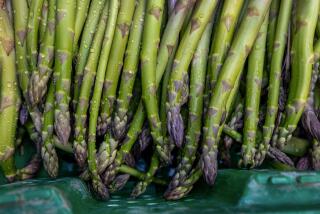Unable to Reap What They Grow
It’s been a punishing year for most California orange growers. But you’d never know it by checking out the produce aisle.
Although prices paid to farmers for this season’s big crop of navel oranges have plunged, supermarket prices in many cases have jumped, outpacing even last year when a freeze wiped out two-thirds of the crop.
Quality problems and competition from imports have helped drive down farm prices for navel oranges to their lowest levels in years, as little as 6 cents a pound according to the Department of Agriculture. Meanwhile, the major Los Angeles-area supermarkets this week were charging 89 cents to 99 cents a pound for the fruit. The retail price for March is averaging $1.01, according to the Western Growers Assn., a produce trade group.
Huge markups like these and on other popular items such as carrots, leaf lettuce and broccoli are part of the reason the produce aisle is the most profitable section of the store, outpacing even in-store bakery operations.
Analysts say produce is easier to mark up than packaged goods, which have retail prices defined by their manufacturers. Produce is also cheaper to begin with because it requires less processing, packaging and marketing, so it takes a huge run-up in price before customers get sticker shock.
Today’s widening gap between wholesale and retail prices for navel oranges is unusual even in the produce aisle.
“[Supermarkets] have learned that they can get a high price,” said Keith Harrison, who grows 80 acres of navel oranges near Fresno. “And they’ve just kept it up there.”
Smaller-size fruit and lower prices have kept Harrison from harvesting most of his crop. At today’s prices, he says, he couldn’t cover his growing and packing costs. If supermarkets don’t discount when farm prices slide, growers complain that it’s hard for them to sell as much of their crop.
“Everyone’s in business to be profitable,” said Matt McInerney, of the Western Growers Assn. “But there is a threshold at which [huge markups depress] demand for certain commodities.”
Supermarkets cite the high cost of doing business and slim operating margins in many other categories for their need to mark up fruit to certain levels. Most insist that they pass lower prices on to consumers in the form of special promotions, however.
“When our wholesaler comes through with reduced prices, we typically get more promotional, offering different things with our ads,” says Ralphs spokesman Terry O’Neal.
Industry consultants counter that supermarkets typically reduce prices on less popular quantities of certain commodities, like cartons of 18 eggs, multi-packs of milk or huge bags of fruit.
This year’s navel crop is large, at 80 million cartons, up slightly from two years ago when the crop was unaffected by freezing temperatures and equal to the 1996-97 season. But because of smaller fruit sizes and competition from imported citrus such as Spanish clementines, average prices have plunged.
Growers are getting $4 to $7 per 37-pound carton depending on size, down from the $6 to $9 they were getting in March 1998 before the freeze, according to California Citrus Mutual.
“These are the same prices we had 10 years ago,” says Jim Marderosian, president of Bee Sweet Citrus in Fowler. “This is equally as bad as a freeze.”
The drop in prices couldn’t have come at a worse time, as growers in the Central Valley recover from last year’s crippling freeze, which knocked out most of the crop. The difference is that this year the losses must be chalked up to the cost of doing business, rather than be mitigated by crop insurance.
Many growers simply aren’t bothering to pick their smaller oranges because it isn’t worth what they’d pay to pick and pack it.
“If I pick this stuff I run the risk of getting a bill for [packing] it,” says Bill Marchiando, who grows oranges in Tulare and Kern counties. “I’m panicking.”
Moreover, supermarkets aren’t helping shippers move their products as they did in the past. Previously, when growers wanted to move more of a large crop, they offered deeper discounts to retailers in exchange for advertising and higher-profile display space at the end of aisles.
But as the major supermarket chains have grown more powerful from consolidations and as imported oranges from such markets as Australia and South Africa give retailers more buying options, domestic growers say even the largest suppliers, such as Sunkist Growers, are afraid to make demands. Sunkist officials declined to comment.
To stir public outrage over fat retail markups, Western Growers last year began loading weekly comparisons between farm prices and retail prices onto its Web site, https://www.wga.com. But few consumers have seen these numbers.
“[Farmers] are doing nothing but wringing, rubbing and fretting about it,” says Connecticut supermarket consultant Christopher W. Hoyt. “Meanwhile, it’s only growing worse.”
(BEGIN TEXT OF INFOBOX / INFOGRAPHIC)
California Orange Crush
California’s navel orange crop supplies the majority of fresh oranges to the nation. The gap between the prices growers receive for their crop and the retail price is widening. In Los Angeles, the retail price for navel oranges in March is averaging $1.01 per pound.
*
U.S. store prices have remained high ...
Average annual retail prices for navel oranges (per pound)
1999: 84 cents per pound
*
... but prices paid to growers are falling.
The 1991 and 1999 seasons were freeze years, driving prices up. Even so, prices California growers receive for their oranges have been declining in the current season:
*
1999: 14 cents per pound
*
February: 6 cents per pound
*
Sources: USDA, National Agricultural Statistics Service, Department of Labor, Bureau of Labor Statistics, Western Growers Assn.
Researched by NONA YATES/Los Angeles Times
More to Read
Inside the business of entertainment
The Wide Shot brings you news, analysis and insights on everything from streaming wars to production — and what it all means for the future.
You may occasionally receive promotional content from the Los Angeles Times.










